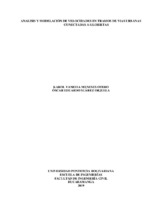Análisis y modelación de velocidades en tramos de vías urbanas conectadas a glorietas

View/
Date
2019xmlui.dri2xhtml.METS-1.0.item-advisor
Pico Vargas, Ricardo
xmlui.dri2xhtml.METS-1.0.item-type
Trabajo de grado
Citación
Metadata
Show full item recordDocuments PDF
Abstract
La infraestructura vial se convierte en una de las principales áreas de la ingeniería civil al aportar movilidad y seguridad vial a cada uno de los usuarios. En este proyecto se pretende analizar los principales factores influyentes sobre la velocidad de operación en vías urbanas las cuales se encuentran conectadas a cinco de las principales glorietas de la dudad de Bucaramanga, con el fin de desarrollar ecuaciones de predicción de velocidad. Se realizó una amplia investigación acerca del tema a trabajar, recopilando información que sirvió como soporte en el momento de analizar los resultados de velocidades de operación y factores influyentes en el estudio del tramo vial escogido. Se ejecutó la toma de los datos a 28 conductores, junto con la toma de velocidades de sus respectivos vehículos mediante el equipo VBOX, se tomaron las características del vehículo y las principales características del conductor, al finalizar cada prueba se entregó un test de personalidad y otro de estilos de conducción, los cuales son necesarios para analizar la influencia del factor humano en el proyecto. Se hizo un conteo de las características de las calles como longitud del tramo, ancho de calzada, número de carriles, ancho de carril y luego así mismo de las características del entorno como número de árboles, postes, accesos y señales de tránsito. La extracción de resultados se llevó a cabo a través de programas y directrices para una evaluación eficiente de los datos, que arrojó resultados en los que predominan rasgos de personalidad y estilos de conducción en términos del factor humano, y en función de las relaciones entre la velocidad de operación V (85) y las características de las carreteras y su entorno encontramos pocas relaciones significativas en términos de su grado de influencia. The road infrastructure becomes one of the main areas of civil engineering, providing mobility and road safety to each of the users. This project aims to analyze the main factors influencing the speed of operation in urban roads that are connected to five of the main roundabouts in the city of Bucaramanga, in order to develop speed prediction equations. A broad investigation was carried out on the subject to work, gathering information that served as support when analyzing the results of operating speeds and influential factors in the study of the road section chosen. The data was taken from 28 drivers, together with the speeding of their respective vehicles through the VBOX equipment, the characteristics of the vehicle and the main characteristics of the driver were taken, at the end of each test a personality test was delivered and another of driving styles, which are necessary to analyze the influence of the human factor in the project. A count was made of the characteristics of the streets such as the length of the section, width of the road, number of lanes, lane width and then the characteristics of the environment such as number of trees, poles, accesses and traffic signals. The extraction of results was carried out through programs and guidelines for an efficient evaluation of the data, yielding results in which personality traits and driving styles dominate in terms of the human factor, and based on the relationships between operating speed V (85) and characteristics of the roads and their environment we found few significant relationships in terms of their degree of influence.
Keyword/s
Velocidad
Vías de tránsito
Glorietas
Seguridad vial
Collections
- Trabajos de grado [6698]
The following license files are associated with this item:

